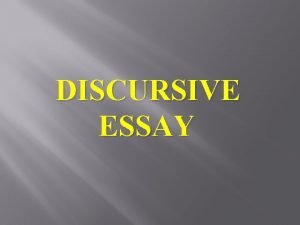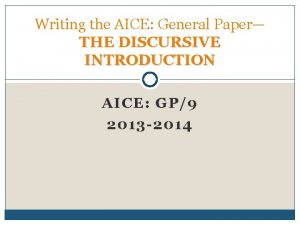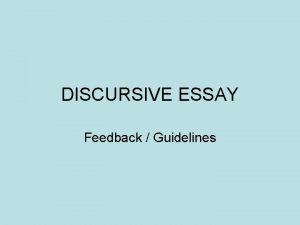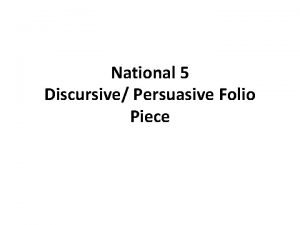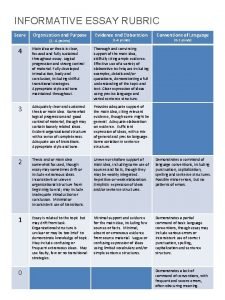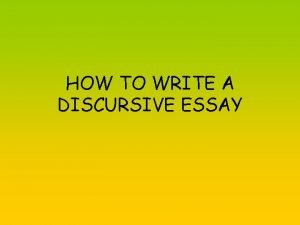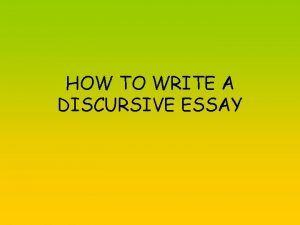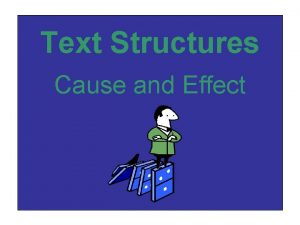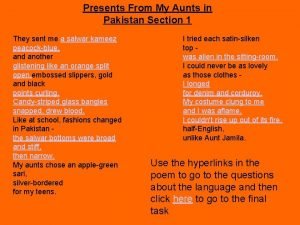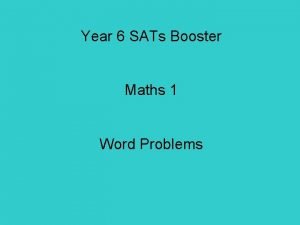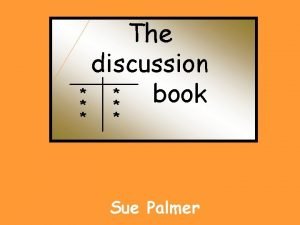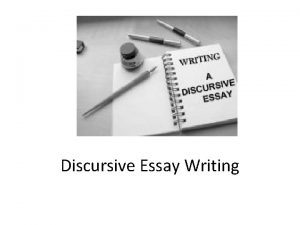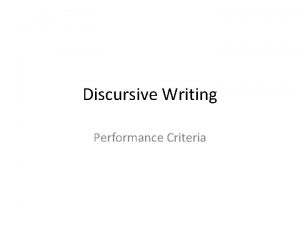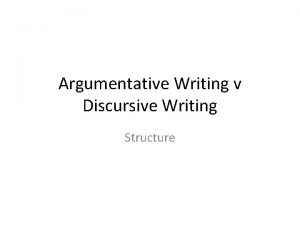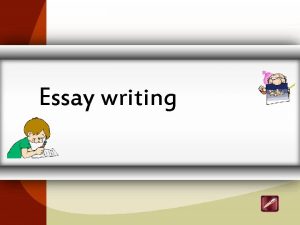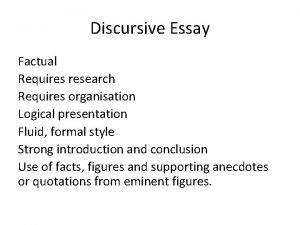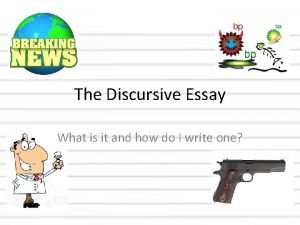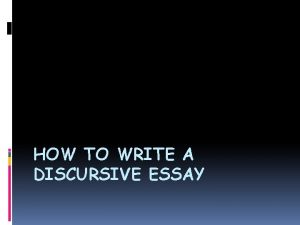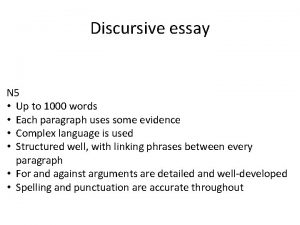DISCURSIVE ESSAY Purpose DISCURSIVE ESSAY It presents a

















- Slides: 17

DISCURSIVE ESSAY

Purpose DISCURSIVE ESSAY � � It presents a balanced and objective examination of a subject. The topic may be controversial, but the discursive essay attempts to present a much more balanced discussion of the issue. ARGUMENTATIVE ESSAY � � It presents the advantages and disadvantages of a certain subject. Its purpose is to both educate and persuade the reader on a particular point of view.

Style DISCURSIVE ESSAY � � They are written in a more formal and impersonal style than other essays. Each issue should be discussed in a separate paragraph and each paragraph should begin with a strong topic sentence. ARGUMENTATIVE ESSAY � � They follow a general format. The writer states an initial thesis that contains the point of view for which the author is arguing. The body generally presents both sides of the argument.

Plan DISCURSIVE ESSAY Introduction � 1 st Issue, situation or problem � 2 nd Issue, situation or problem � Conclusion � ARGUMENTATIVE ESSAY Introduction � Arguments for / against � Arguments against / for � Conclusion �

A good discursive essay should consist of: � � � an introductory paragraph (you clearly state the topic to be discussed), a main body (points are clearly stated in separate paragraphs (2 - 3) and exemplified or justified), a closing paragraph summarising the main points of the essay (you restate your opinion, and/or give a balanced consideration of the topic).

Formal style of discursive essays This means you should use: � � � passive voice, impersonal constructions (e. g. It is argued that. . . ; It is a common belief that…), a range of advanced vocabulary (verbs, adjectives, abstract nouns, etc) (e. g. heated debate concerning the controversial issue…), formal linking words/phrases (e. g. furthermore, however, nonetheless), complex sentences with a variety of links, dependent clauses (e. g. Furthermore, a tendency to self-concentration and egoism might rise when one start measuring everything from a profit-making perspective. ), inversion, especially in conditionals (e. g. Never has this been more obvious…).

You should not use: � � � short forms (e. g. I'm; It’s) except when these are part of a quotation, colloquial expressions, phrasal verbs, idioms (e. g. lots of, put up with, be over the moon about…), simplistic vocabulary (e. g. Experts say they think this is bad…. ), a series of short sentences (e. g. Many people think so. They are wrong. ), simple linking words (e. g. and, but, so).

In simple terms, this means the following: Do not use Write in proper, complete sentences Abbreviations (i. e. /e. g. /etc. /UK/&) Use complete words and expressions Contractions (isn't/don't/won't) Use proper, standard English Slang (e. g. bloke/geezer etc) Colloquial language (mate/bolshy etc. )

Linking Words To provide an illustration / to give an example: � � � � � for example that is to say for instance in other words namely such as as follows a typical/particular/key example � � � � typical of this including especially in particular mainly most importantly a good illustration of this is it is interesting to note

Linking Words To extend a point / to add: � � � similarly equally likewise also furthermore indeed � � � in the same way besides above all as well in addition moreover

Linking Words To show the next step: � � � � first(ly) second(ly) third(ly) finally to begin/start with in the first/second place first and foremost � � � � first and most importantly another then after next afterwards ultimately

Linking Words To indicate a contrast: � � � however on the other hand alternatively in contrast instead (of) conversely on the contrary in fact in comparison another possibility while � � � whereas but better/worst despite this in spite of although nevertheless notwithstanding for all that yet in opposition to this

Linking Words To show cause and effect: � � � � so therefore accordingly hence as a result /consequence resulting from in consequence of this consequently � � � � because of this/that for this reason owing to/due to the fact this demonstrates it follows that this suggests that accepting/assuming this

Linking Words To conclude: � � � in conclusion it can be concluded this implies in short to conclude to sum up � � all in brief all things considered taking everything into account

The Role of Marriage in Today’s Society If there is one thing that virtually all the world‘s cultures have in common, it is marriage. Beliefs, diet and languages vary greatly, but the desire people have to share their lives with another seems universal. Why, then, is marriage so popular? Psychologists have said that people have a deep need for the emotional security which mariage provide. Knowing that one has a partner in life makes it easier to cope with the problems of daily life. On the other hand, the fact that many single people are content to live alone suggests that the “emotional need” theory is incomplete. British novelist Fay Weldon once stated, “Marriage has nothing to do with emotion and everything to do with property. ” According to the supporters of this view, people marry in order to increase their wealth, either by marrying a rich partner or because, as the saying goes, “two can live cheaply as one. ” It is true that financial considerations are often the primary reason that people marry. However, there are countless examples of people “marrying for love”, regardless of their mate’s lack of money. All in all, marriage continues to be extremely popular in many societies. Most of us have a need for love and support and want to have children at some point in our lives. Fully understanding the reason why people marry, though, may be as difficult as understanding the human mind itself.

Paragraph Plan � � Paragraph 1: state topic (why is marriage so popular? ) Paragraph 2: ‘emotional’ need for a partner; comparison between single/married people Paragraph 3: why people marry – for love/money Paragraph 4: make general comments (difficult to fully understand reason why people marry)

References & Other Sources � Evans Virginia, 2006: Successful Writing (Upper. Intermediate). Newbury: Express Publishing, 2006. � http: //classroom. synonym. com/difference-betweendiscursive-argumentative-essays-2616. html � http: //academicwriting. wikidot. com/what-is-an-essay � http: //www. alvaacademy. clacks. sch. uk/docs/Discursiv e%20 Essay%20 Booklet%20 DPT. pdf
 Discursive purpose
Discursive purpose Aice general paper hand approach
Aice general paper hand approach Discursive writing examples
Discursive writing examples Discursive writing
Discursive writing Aice prompts
Aice prompts National 5 discursive essay examples
National 5 discursive essay examples Discursive essay rubric
Discursive essay rubric Discursive essay plan
Discursive essay plan Discursive essay plan
Discursive essay plan Marco giugni ferrari
Marco giugni ferrari Key words for cause and effect text structure
Key words for cause and effect text structure Presents from my aunts in pakistan
Presents from my aunts in pakistan Presents from my aunts in pakistan poem analysis
Presents from my aunts in pakistan poem analysis Sally elatta presents on business agility
Sally elatta presents on business agility 16 3 darwin presents his case answer key
16 3 darwin presents his case answer key Section 15-3 darwin presents his case answers
Section 15-3 darwin presents his case answers Zids and zods
Zids and zods Discussion text
Discussion text
